
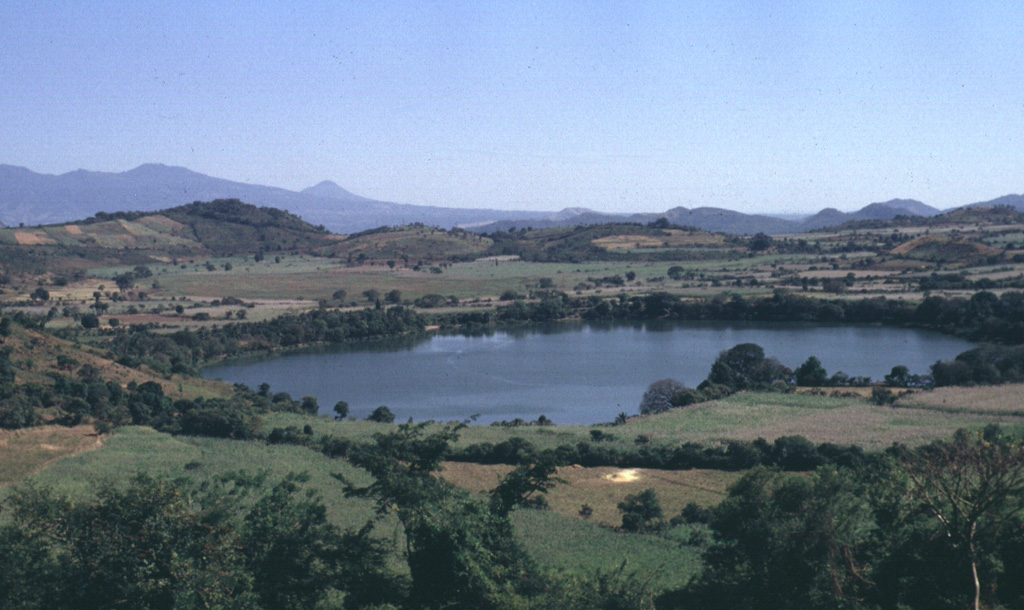
The Global Volcanism Program has no activity reports available for Apastepeque Field.
The Global Volcanism Program has no Weekly Reports available for Apastepeque Field.
The Global Volcanism Program has no Bulletin Reports available for Apastepeque Field.
|
|
||||||||||||||||||||||||||
The Global Volcanism Program is not aware of any Holocene eruptions from Apastepeque Field. If this volcano has had large eruptions (VEI >= 4) prior to 12,000 years ago, information might be found on the Apastepeque Field page in the LaMEVE (Large Magnitude Explosive Volcanic Eruptions) database, a part of the Volcano Global Risk Identification and Analysis Project (VOGRIPA).
This compilation of synonyms and subsidiary features may not be comprehensive. Features are organized into four major categories: Cones, Craters, Domes, and Thermal Features. Synonyms of features appear indented below the primary name. In some cases additional feature type, elevation, or location details are provided.
Cones |
||||
| Feature Name | Feature Type | Elevation | Latitude | Longitude |
| Bengo, Cerro | Pyroclastic cone | 700 m | 13° 42' 0.00" N | 88° 50' 0.00" W |
| Chalchuapa, Cerrito de | Pyroclastic cone | 450 m | 13° 43' 0.00" N | 88° 45' 0.00" W |
| San Sebastián, Cerro de | Pyroclastic cone | 600 m | 13° 44' 0.00" N | 88° 48' 0.00" W |
| Santa Clara, Cerrito de | Pyroclastic cone | 500 m | 13° 42' 0.00" N | 88° 44' 0.00" W |
Craters |
||||
| Feature Name | Feature Type | Elevation | Latitude | Longitude |
| Apastepeque, Laguna | Pit crater | 512 m | 13° 42' 0.00" N | 88° 45' 0.00" W |
| Chalchuapán, Laguna de
Chalchuapa, Laguna de |
Pit crater | 560 m | 13° 43' 0.00" N | 88° 45' 0.00" W |
| Hoyo de Calderas | Crater | 640 m | 13° 42' 0.00" N | 88° 44' 0.00" W |
| San Lorenzo | Pit crater | 13° 43' 0.00" N | 88° 48' 0.00" W | |
| Santa Ursula | Pit crater | 13° 43' 0.00" N | 88° 47' 0.00" W | |
| Seca, Laguna | Pit crater | 13° 41' 0.00" N | 88° 44' 0.00" W | |
| Ventanita | Pit crater | 13° 43' 0.00" N | 88° 46' 0.00" W | |
Domes |
||||
| Feature Name | Feature Type | Elevation | Latitude | Longitude |
| Apastepeque, Cerro de | Dome | 13° 40' 0.00" N | 88° 45' 0.00" W | |
| Cerrón, Cerro
Ramirez, Cerro de los |
Dome | 740 m | 13° 40' 0.00" N | 88° 45' 0.00" W |
| Delicias, Cerro las | Dome | 760 m | 13° 41' 0.00" N | 88° 47' 0.00" W |
| Grande, Cerro | Dome | 926 m | 13° 41' 0.00" N | 88° 49' 0.00" W |
| Santa Rita, Cerro | Dome | 754 m | 13° 40' 0.00" N | 88° 47' 0.00" W |
| Tute, Cerro El | Dome | 13° 43' 0.00" N | 88° 44' 0.00" W | |
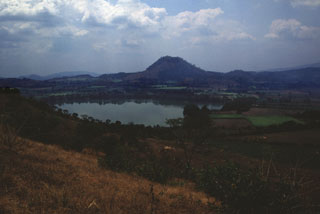 Cerro El Cerrón, one of the largest lava domes of the Apastepeque volcanic field, is seen here beyond Laguna de Apastepeque.
Cerro El Cerrón, one of the largest lava domes of the Apastepeque volcanic field, is seen here beyond Laguna de Apastepeque. 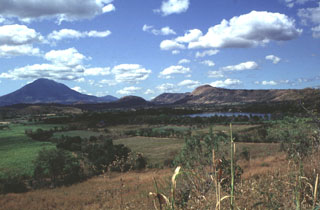 The Apastepeque volcanic field consists of a cluster of about two dozen lava domes, scoria cones, and craters NE of San Vicente volcano, the large edifice to the left. The Laguna de Apastepeque crater is to the right, below Cerro Las Delicias lava dome. Near the center of the horizon is Cerro Santa Rita lava dome.
The Apastepeque volcanic field consists of a cluster of about two dozen lava domes, scoria cones, and craters NE of San Vicente volcano, the large edifice to the left. The Laguna de Apastepeque crater is to the right, below Cerro Las Delicias lava dome. Near the center of the horizon is Cerro Santa Rita lava dome.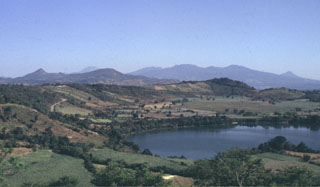 Laguna de Apastepeque in the foreground is one of several lake-filled maar craters in the Apastepeque volcanic field. The broad range in the distance to the right is the SE is the Tecapa massif. To the far right is the peak of Volcán Taburete. San Miguel volcano is in the midground to the left.
Laguna de Apastepeque in the foreground is one of several lake-filled maar craters in the Apastepeque volcanic field. The broad range in the distance to the right is the SE is the Tecapa massif. To the far right is the peak of Volcán Taburete. San Miguel volcano is in the midground to the left. The Apastepeque volcanic field NE of San Vicente volcano consists of a dense cluster of about two dozen lava domes, scoria cones, and maars. Laguna de Apastepeque is seen here from the WNW with the Tecapa-San Miguel volcano group in the background. The visible walls of the 800-m-wide lake are only about 5 m high and the lake is approximately 50 m deep.
The Apastepeque volcanic field NE of San Vicente volcano consists of a dense cluster of about two dozen lava domes, scoria cones, and maars. Laguna de Apastepeque is seen here from the WNW with the Tecapa-San Miguel volcano group in the background. The visible walls of the 800-m-wide lake are only about 5 m high and the lake is approximately 50 m deep.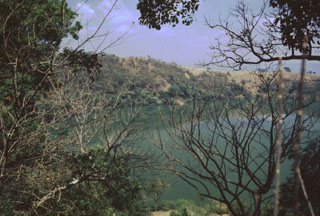 Laguna Chalchuapán is one of several maars in the Apastepeque volcanic field. The 700-m-wide crater is located immediately NE of the Hoyo de Calderas crater. Lahar deposits underlie pumice deposits exposed in the crater walls.
Laguna Chalchuapán is one of several maars in the Apastepeque volcanic field. The 700-m-wide crater is located immediately NE of the Hoyo de Calderas crater. Lahar deposits underlie pumice deposits exposed in the crater walls. 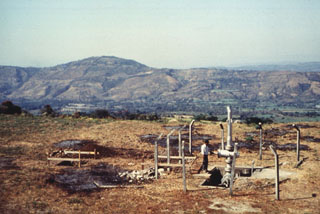 San Vicente is one of several volcanoes that have been the sites of geothermal exploration projects in El Salvador. The SV-1 well in the foreground is located on the northern flank. The low Cerro el Cerrón lava dome, part of the Apastepeque volcanic field, is to the NE on the left horizon.
San Vicente is one of several volcanoes that have been the sites of geothermal exploration projects in El Salvador. The SV-1 well in the foreground is located on the northern flank. The low Cerro el Cerrón lava dome, part of the Apastepeque volcanic field, is to the NE on the left horizon.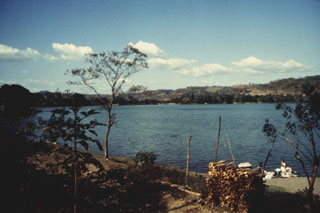 Laguna de Apastepeque is one of several large lake-filled maars in the Apastepeque volcanic field. The 800-m-wide lake is about 50 m deep and is surrounded by ash deposits containing angular blocks of andesite.
Laguna de Apastepeque is one of several large lake-filled maars in the Apastepeque volcanic field. The 800-m-wide lake is about 50 m deep and is surrounded by ash deposits containing angular blocks of andesite.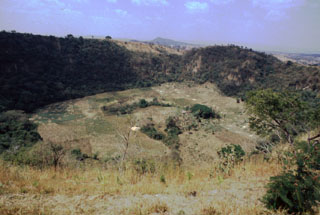 Hoyo de Caldera is a maar crater located NW of Laguna de Apastepeque. The crater is 700 m wide and 140 m deep, seen here from the SE in 1999.
Hoyo de Caldera is a maar crater located NW of Laguna de Apastepeque. The crater is 700 m wide and 140 m deep, seen here from the SE in 1999. 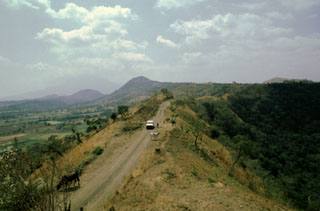 Several different features of the Apastepeque volcanic field can be seen in this view from the Hoyo de Calderas crater rim. Two lava domes are seen in the distance to the left, Cerro Las Delicias and Cerro Santa Rita (far left). The larger volcano in the haze behind Cerro Santa Rita is San Vincente.
Several different features of the Apastepeque volcanic field can be seen in this view from the Hoyo de Calderas crater rim. Two lava domes are seen in the distance to the left, Cerro Las Delicias and Cerro Santa Rita (far left). The larger volcano in the haze behind Cerro Santa Rita is San Vincente.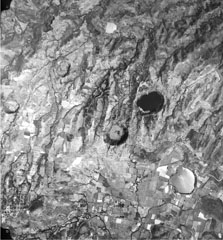 Several maars of the Apastepeque volcanic field are seen in this vertical aerial view. The two lake-filled maars are Laguna de Apastepeque (the light-colored lake at the lower right) and Laguna Chalchuapa (the dark-colored lake at the right-center). SW of it is the large dry maar Hoyo de Calderas, and other dry maars appear at the upper left and lower right. The Pan-American highway cuts across the bottom of the photo, and the town of San Esteban Catarina is at the lower left, immediately west of Cerro Las Delicias lava dome.
Several maars of the Apastepeque volcanic field are seen in this vertical aerial view. The two lake-filled maars are Laguna de Apastepeque (the light-colored lake at the lower right) and Laguna Chalchuapa (the dark-colored lake at the right-center). SW of it is the large dry maar Hoyo de Calderas, and other dry maars appear at the upper left and lower right. The Pan-American highway cuts across the bottom of the photo, and the town of San Esteban Catarina is at the lower left, immediately west of Cerro Las Delicias lava dome. There are no samples for Apastepeque Field in the Smithsonian's NMNH Department of Mineral Sciences Rock and Ore collection.
| Copernicus Browser | The Copernicus Browser replaced the Sentinel Hub Playground browser in 2023, to provide access to Earth observation archives from the Copernicus Data Space Ecosystem, the main distribution platform for data from the EU Copernicus missions. |
|
WOVOdat
Single Volcano View Temporal Evolution of Unrest Side by Side Volcanoes |
WOVOdat is a database of volcanic unrest; instrumentally and visually recorded changes in seismicity, ground deformation, gas emission, and other parameters from their normal baselines. It is sponsored by the World Organization of Volcano Observatories (WOVO) and presently hosted at the Earth Observatory of Singapore.
GVMID Data on Volcano Monitoring Infrastructure The Global Volcano Monitoring Infrastructure Database GVMID, is aimed at documenting and improving capabilities of volcano monitoring from the ground and space. GVMID should provide a snapshot and baseline view of the techniques and instrumentation that are in place at various volcanoes, which can be use by volcano observatories as reference to setup new monitoring system or improving networks at a specific volcano. These data will allow identification of what monitoring gaps exist, which can be then targeted by remote sensing infrastructure and future instrument deployments. |
| IRIS seismic stations/networks | Incorporated Research Institutions for Seismology (IRIS) Data Services map showing the location of seismic stations from all available networks (permanent or temporary) within a radius of 0.18° (about 20 km at mid-latitudes) from the given location of Apastepeque Field. Users can customize a variety of filters and options in the left panel. Note that if there are no stations are known the map will default to show the entire world with a "No data matched request" error notice. |
| UNAVCO GPS/GNSS stations | Geodetic Data Services map from UNAVCO showing the location of GPS/GNSS stations from all available networks (permanent or temporary) within a radius of 20 km from the given location of Apastepeque Field. Users can customize the data search based on station or network names, location, and time window. Requires Adobe Flash Player. |
| Large Eruptions of Apastepeque Field | Information about large Quaternary eruptions (VEI >= 4) is cataloged in the Large Magnitude Explosive Volcanic Eruptions (LaMEVE) database of the Volcano Global Risk Identification and Analysis Project (VOGRIPA). |
| EarthChem | EarthChem develops and maintains databases, software, and services that support the preservation, discovery, access and analysis of geochemical data, and facilitate their integration with the broad array of other available earth science parameters. EarthChem is operated by a joint team of disciplinary scientists, data scientists, data managers and information technology developers who are part of the NSF-funded data facility Integrated Earth Data Applications (IEDA). IEDA is a collaborative effort of EarthChem and the Marine Geoscience Data System (MGDS). |